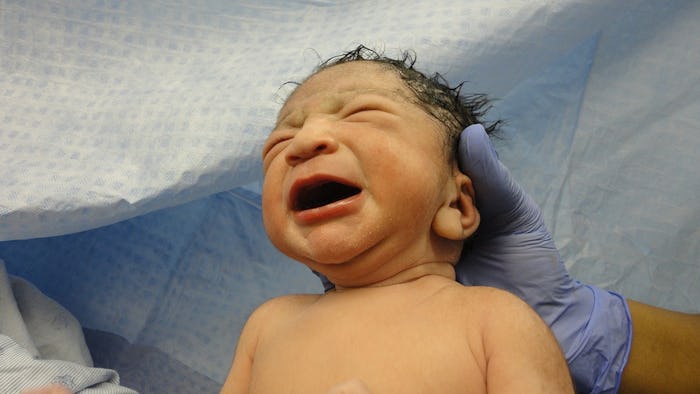When I was pregnant, it seemed like every horrific tale of childbirth was shared with me (without my asking, mind you). Stories of what could go wrong and all the ways my baby could suffer seemed to flood my brain. All this information had me in such an anxious state that I brought it up to my obstetrician at my 30 week appointment. She assured me that safe and healthy births happened way more often than traumatic ones, but also covered some labor and delivery red flags with me so I could sleep better at night.
My doctor also encouraged me to focus on all the things that could go right, and how to prepare my body for a trouble-free delivery. This was an effective tool, but if I'm being honest, I think it's next to impossible for any mother — especially first timers — to not have some lingering fears and concerns about giving birth. But it is empowering to have the knowledge of what's happening when you see the doctor and nurse give each other that look while you're pushing. Understanding these 10 possible risks during labor and delivery will give you a working knowledge of potential issues and the outcomes.
1Breech Position
For optimum delivery position, babies should come out head first. So when the feet or bum is lined up with the birth canal, some problems could arise. According to the website for the American Pregnancy Association (APA), "a baby’s head is the last part of its body to emerge in a breech birth, making it more difficult to ease it through the birth canal. This means that doctors may either attempt to turn the baby in the womb or recommend a cesarean delivery to avoid complications from a vaginal birth.
2Shoulder Dystocia
As the baby is emerging from the mother, it's possible for the newborn to become stuck before making it all the way out. Shoulder dystocia is when a baby's shoulders become stuck in the birth canal after the head has come out, as the website for the March of Dimes explained. This can potentially cause nerve damage and lack of oxygen for the baby as well as heavy bleeding and tears for the mother.
3Cord Prolapse
When the umbilical cord gets a head starts and slips through the cervix and into the birth canal before the baby does during labor, it's referred to as cord prolapse, according to What To Expect's website. This is a concern during delivery because the cord could become compressed when your baby's head is pushes against the cord, affecting their oxygen supply.
4Fetal Distress
Fit Pregnancy magazine explained that an Electronic Fetal Heart Monitor is used in order to monitor the baby's heart rate and oxygen levels for signs of distress during labor. As the website for the U.S. National Library of Medicine pointed out, certain fetal heart rate patterns indicate that the baby does not have adequate oxygen and discovering this during labor can lead to intervention.
5Prolonged Labor
You've heard the stories of when who were in the first stage of labor for an unfathomable amount of hours, but when labor drags on in the final stage, problems can occur. According to the APA, prolonged labor is when no progress is being made in a reasonable amount of time, which is why it's also called failure to progress. Although the causes can be different, prolonged labor usually means you'll be headed for a C-section.
6Fetopelvic Disproportion
One of the reasons you experience prolonged labor is when the mother's pelvis is too small for the baby's head to fit through, as the online Medical Dictionary explained. This is how I ended up with a C-section, and I can tell you after two hours of pushing with no progress, I was finally relieved to know what was the cause of the problem.
7Meconium Aspiration
When there is a code brown during labor, a baby may need to be monitored for side effects. If a baby poops in the womb or during delivery, there is a possibility they can inhale some of the meconium (first bowel movement), according to Kid's Health, a website from Nemours. Meconium Aspiration Syndrome occurs when the inhaled meconium interferes with the baby's breathing, although the severity depends on the amount breathed in.
8Placental Abruption
According to Baby Center, placental abruption is a serious condition when the placenta partially or completely separates from your uterus before your baby's born. Although it's likely you'll have symptoms of this before going into labor, depending on how far along you are in your pregnancy, this condition may mean you will be delivering right away, as Healthline pointed out.
9Nuchal Cord
Aside from slipping out too soon, the umbilical cord can cause one other problem. Nuchal cord is when the umbilical cord wraps around the baby's neck, according to Fit Pregnancy. This is only an issue when the cord is too tight and causes the baby's hear rate to slow down. Usually, the doctor can quickly unwrap the cord or manually release the pressure from around the baby's neck.
10Placenta Previa
As the March of Dimes explained, when the placenta blocks the cervix it is called placenta previa. The problem with this is, the cervix is the exit door for the baby, and if that is blocked the delivery will happen via C-section.
